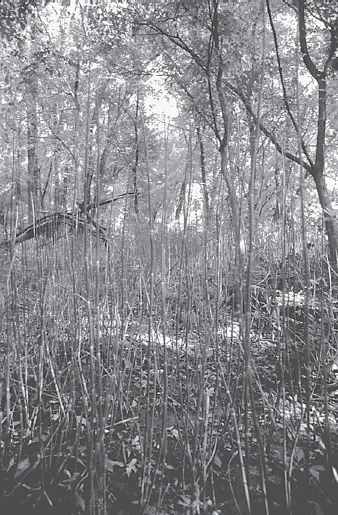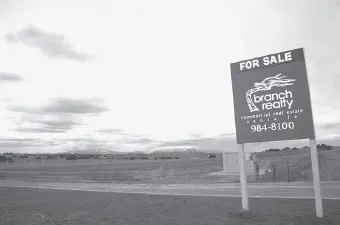![]()
Principle 1:
Keep Healthy Sites Healthy
The first rule of the tinkerer is to keep all the pieces.
—Aldo Leopold, quoted by E. O. Wilson in Biophilia
Discussed in This Chapter
Identifying healthy and unhealthy sites.
How site knowledge forms the basis for sustainable work.
Dealing with pre-construction impacts through teamwork.
General protection strategies applicable to any important site feature.
Protection of specific features like soil, vegetation, or water bodies.
Choice of construction equipment and construction planning.
Every site resembles a living organism, and like organisms, sites vary in health. This chapter discusses what “site health” means, and methods for preserving it during construction. Like human health, site health is not easy to define in a simple formula. Prevention is usually more successful—and less expensive—than cure.
Protection of sites—particularly those with mature vegetation and healthy soils—is of increasingly critical importance because deforestation links to global climate change (see p. 20). Site protection can make both local and cumulative differences.
Landscape construction that accidentally or deliberately damages a healthy site is doubly wasteful. While restoration methods can repair many site injuries, there is a point of no return, beyond which restoration is neither cost-effective nor ecologically sufficient. Mature trees needlessly destroyed in construction are not effectively “restored” by planting saplings, for example. Thus, the first principle of sustainable landscape construction is self-evident yet easily overlooked: avoid harm to healthy sites.
Protecting a healthy site requires care throughout the design and construction process, from initial reconnaissance through final cleanup. Sustainable design anticipates and integrates appropriate construction methods, influencing choices about siting, structures, and materials. The quality and coordination of such choices can make the difference between irreparable damage and minimal impact.
What Is a Healthy Site?
“Health” is one of those conditions everyone knows when they see it, but which remains impossible to define completely. Despite this difficulty, it is important for both ecological and economic reasons to develop at least an operational definition of what “site health” means.
It is fairly easy to say when a site is unhealthy: stripped of topsoil by natural erosion or human carelessness, polluted by chemicals, supporting only a small percentage of the richness of plant and animal life found in the region, or overrun with invasive species, sick sites are often obvious eyesores.
Some site “illnesses” are brief ones, with quick recovery. A site drowned in sediment by a flood, or burned by a forest fire, may look unhealthy but usually retains vitality and soon begins regrowth. In fact, many plant communities and soil types depend on such events for long-term health. A site that is healthy and has plentiful resources (water, soil fertility, sunlight) can recover from minor construction damage, too.
More serious ill health results when toxic chemicals are involved, or when soil is removed, massively eroded, compacted, or paved. Some plant and animal species invade the site in much the way that parasites, microbes, or even cancers invade the human body.1
The cumulative effect of small, normal stresses also affects site health. Individual factors like wind, temporary drought, or increased ultraviolet radiation can add up over time to weaken plant life that holds a site together. Human use of a site produces new stresses. A site that had limited resources to start with may be unable to adapt to added stress.
Like healthy humans, healthy sites are productive, have vitality enough to keep growing despite some stress, and generally have a satisfying “look” and “feel.” The appearance of a site can tell much about its health. Some healthy sites, however, go through messy-looking phases, and some landscapes conventionally viewed as stylish conceal serious ill health. Conventional landscape aesthetics are not a reliable guide to site health. (See Figures 1.1 and 1.2.)
Healthy ecosystems provide what have been called “environmental services,” such as keeping air and water clean, improving local climate, and creating food—services on which human life depends.2 (These services are discussed in more detail in Principle 11.) Healthy sites also provide many amenities. Compared to landscapes cleared and flattened for convenience in construction, healthy sites have significantly higher property values (by at least 5–20 percent).3
Healthy sites are recognizable by several characteristics:
- They support diversity of plant and animal life adapted to the region and linked to one another in a web of interdependence.
- They are seldom dominated exclusively by one species, and especially not by species imported there by humans. (Criteria for agricultural sites are different, but crop monocultures are also unhealthy, sacrificing health for high productivity.)
- Their communities or ecosystems (soil, plants, and animals) are essentially self-maintaining, not dependent on outside resources supplied by people.
- Their living species are actively reproducing at rates typical of each species.
- The geological portion of the site is not changing too rapidly to support the living community, nor poisoned or infertile.
- The site has sufficient vitality and resilience to overcome a variety of stresses.
- The community changes with age through a process called succession.
Succession is a regionally characteristic series of changes. Healthy meadow or bog may be superseded by healthy forest. Unlike invasion by imported species, succession is healthy. It is like the changes in a healthy human from infancy through adolescence, maturity, decline, and death—and in the case of plant communities, succession includes rebirth. Accelerating or holding back succession without weakening the site’s health is one of the most sophisticated methods of site management. Excessively slow or fast succession, like unusual aging in people, can indicate ill health.
It is seldom up to a single construction or design professional to decide precisely how healthy a site is. However, if developers, designers, and contractors learn to recognize relatively healthy sites, such sites will be valued and protected more often. Some clients still insist that unhealthy is good: less brush to clear. But recognition and protection of site health is increasingly required of landscape professionals.
One extremely valuable way of assessing the health of land at a site scale is the Floristic Quality Assessment (FQA). The method was developed at the Morton Arboretum (Lisle IL); published in 1994,4 it offers a consistent means of evaluating any site. Plant species are known as “opportunistic” (a.k.a. wide) if they adapt easily to different site conditions, including disturbance by human activities; plants that are adapted to and require more specific conditions are termed “conservative.” FQA uses a regional list of all plants known to occur there; each species is assigned a “coefficient of conservatism” (CC), a value between 0 (extremely adaptable, likely invasive) to 10 (dependent on and indicative of specific undisturbed local soil and ecosystem conditions). For a specific site, an inventory of species found on that site is taken, and the CC values for all species are averaged. The higher the average, the more healthy the site and the more valuable to protect.
The value of FQA is that it integrates complex information about soil health, species interactions and coevolution, and disturbance into a single metric that can be applied to field data. The method is used in all fifty states (each using a regional database of plant species) and by many federal agencies. It has proven ecologically accurate as well as legally defensible, so it is used in mitigation and restoration planning, including monitoring of mandatory restoration projects. It also correlates to the level of ecosystem services, with low FQA scores predicting decreased levels of air and water quality and other critical “services.” An online calculator, with several dozen regional databases, is available free to anyone wishing to test the floristic quality of any site.5 By sharing FQA reports, a kind of crowdsourcing is rapidly improving site and regional understanding of ecosystem health.6
There are a number of other commonly used “biodiversity index” methods, easily found online. They vary in whether they simply count the number of species, or weight more complex concerns (e.g., whether in a mix of many species, a few species dominate while most have only a few individual representatives). It is the weighting of “conservatism” that distinguishes FQA for site evaluation and facilitates crowdsourced floristic data collection.
Take a Role in “Pre-construction”
Prior to what is conventionally considered the beginning of either design or construction work, a great deal can happen to the site. The pre-construction actors are likely to be realtors, surveyors, developers, utility companies, and governmental agencies. Increasingly, projects stand or fall on the input of neighborhood groups as well.
Landscape professionals can influence most of these groups toward sustainable practice—but only if they form strong channels of communication and give input at the right time. Failing this, these same groups will act on the site, often by default, before landscape professionals are involved. Some standard practices—including hiring a landscape consultant only at the last moment to “shrub up” an already completed design—attempt to disguise unsightly or unhealthy results. Although not easy, winning influence over land-use planning is critically important to sustainability. The teamwork required among landscape architect, contractor, architect (or other consultants), and client or user is a good place to start forging community connections.
Figure 1.1 Assessing site health visually can be misleading. This site fits the conventional image of landscape health, but it may use or pollute resources unsustainably. (Photo: Kim Sorvig.)
Figure 1.2 Messiness is commonly equated with ill health, but this site is growing back from flooding—an important part of a healthy life cycle in any floodplain. (Photo: Kim Sorvig.)
Prevent “Pre-clearance”
One very specific pre-construction practice is increasingly unacceptable in light of the clear links between vegetation loss and global warming (see p. 20). This is the practice of “pre-clearance”—bulldozing a site flat and removing all vegetation and much of the top-soil before putting up a For Sale sign. Although realtors clearly believe flattened sites are attractive to commercial buyers, pre-clearance is truly destructive. Convenient, perhaps, for a big box or parking lot, but what if a corporation wanted to create a model green headquarters? Much of the incentive, and many “environmental services,” are now destroyed. Pre-clearance is likely an end run around development permit processes—if the site is cleared before the regulatory process begins, there is nothing left to regulate.
Sometimes pre-cleared sites lie naked and vacant for years, waiting for sale, planning, design, and construction. During that time, for absolutely no reason, all the air and water benefits of healthy plants and soils are lost.
Site clearance not only should be kept to a minimum but also should not be done any longer in advance than truly necessary. Responsible, sustainability-oriented developers will not pre-clear. Unfortunately, some conventional realtors and developers have to be threatened with legal penalties before they consider anything beyond their own interests. No site should ever be cleared until a specific master plan or design has been approved.
Do Your Homework First: Knowledge as Sustainability
Those who think that site analysis before design or construction is expensive need to consider the costs of ignorance, which are always far greater.
There are two kinds of “homework” involved in protecting a healthy site. The information gained from each applies to every subsequent step of sustainable landscape work, from design through maintenance. The first involves attitude; the second, facts.
Figure 1.3 “Pre-clearance” destroys potential and actual site benefits, for reasons that aren’t even commercially valid. (Photo: Kim Sorvig.)
It is impossible to protect what you don’t respect. Even with a strong love of nature, working on a site involves carefully setting priorities, and in many cases, reeducating clients and coworkers. Attitudes about preserving natural conditions have a strong influence on design and construction priorities. Is the desire for home soccer practice worth flattening the backyard? Is impressing the neighbors j...



